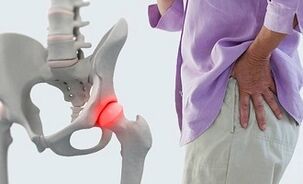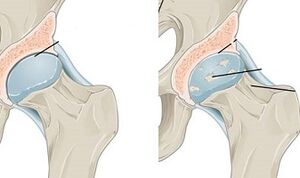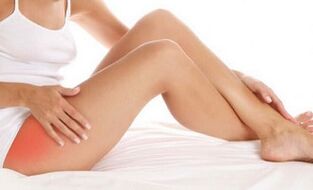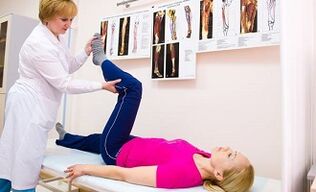
Our body is a complex system in which the breakdown of a "screw" causes other "parts" to fail. In addition to diseases of the internal organs, chronic diseases of the musculoskeletal system, especially the joints, also cause many problems. Today I propose to discuss osteoarthritis of the hip joint. What are the symptoms and recommended treatments.
This joint is the largest in the human skeleton. It is constantly used during walking, bending, turning, so the disease causes the patient severe pain and stiffness in movements. Fortunately, with early diagnosis, the disease is best treated with medication. It is not so easy to suspect that something is wrong, you need to know all the features of the disease and be able to see its first manifestations. Of course, look for ways to prevent this, and our article will help.
Osteoarthritis or osteoarthritis of the hip joint is also called coxarthrosis, all of which have the same meaning - a progressive disease complicated by the destruction of cartilage covered by the femoral head and acetabulum. As a result, the joint gradually collapses, becomes a bone, grows, and loses mobility.
What is coxarthrosis
Let's take a closer look at what coxarthrosis is, as it is a term often used by doctors as the word "osteoarthritis" has recently been removed from medical terminology, as it was previously believed to have nothing to do with inflammation, but scientists have since proven otherwise. For us, these arguments are not important, the main thing is that all these names refer to the same unpleasant disease.
Thus, coxarthrosis is a degenerative-dystrophic disease that causes destruction and deformation of cartilage tissue. It is mainly diagnosed in women over 40 and in men at 60.
Why is there so much injustice in the eyes of women against nature? The point here is in the special structure of the female skeleton and especially in the load on the hip joint during childbirth and delivery. As a result, middle-aged women are more likely to suffer from this disease; The number of patients of different sexes in the elderly age category is gradually equalizing.
Causes of osteoarthritis of the hip joint
There are many causes of osteoarthritis in the hip joint.
The most common of these are:
- heredity, if you have such a disease in your parents or one of your relatives, then you should pay more attention to your health, because the disease itself is not genetically related, but predisposition to metabolic diseases and other problems can cause joint problems;
- Strong loads on the pelvis, especially in running, jumping, weightlifting athletes;
- Obesity, even a slight weight gain can be negative for the joints, which puts an increasing burden on them, which is why obese people are more prone to osteoarthritis;
- injuries, fractures, pelvic bruises;
- Endocrine diseases such as diabetes can cause bone problems;
- inflammatory, infectious processes in the body, such as purulent or rheumatoid arthritis;
- Presence of problems with the spine or bones (straight legs, scoliosis, osteochondrosis) changes posture and stress in the joints;
- hormonal imbalance;
- weakening of blood circulation in tissues;
- sedentary lifestyle;
- Aging associated with deterioration of tissue nutrition.
Coxarthrosis rate
Doctors distinguish 3 degrees or stages of development of the disease, which will help to distinguish the main symptoms. It is important to know that in the first stage, the disease can be completely cured and forgotten for many years, and in the third stage, the only correct decision will be surgery, otherwise the patient is threatened with disability.
Step 1
The following symptoms will help determine the presence of osteoarthritis in grade 1 thigh:
- pain during and immediately after a heavy load on the joint;
- localization of pain only in the area of the bone junction;
- gait is not changed;
- not to be lame;
- Muscles maintain strength and shape.
During a computer diagnostics, the doctor may see bone growths on the surface of the joint, especially along the inner and outer edges of the acetabulum. Properly selected medications at this stage allow the joint to fully recover, but not all of us tend to run to the doctor at the first sign of pain.
Admit it, a little anxiety often makes you think about tension, exhaustion, fatigue. We start rubbing the wound with various creams and ointments, trying to heal with folk methods without understanding the cause and without wasting valuable time. Therefore, if you feel pain in your feet, you should first consult a doctor, taking some time for yourself - this is the key to a long, saturated and happy life!
Step 2

If the problem is not diagnosed and treated immediately, second-degree osteoarthritis characterized by the following symptoms gradually develops:
- more frequent pain that may appear even with inactivity;
- The pain is no longer limited to the area of the bone joint, but spreads to the thigh, groin, and back;
- movements are limited, the person can not move the foot completely to the side;
- looks lame.
During the examination, the images show bone growth at the edge of the cavity, an increase in the top of the bone, edge displacement, and destruction.
Fortunately, with the help of complex therapy, grade 2 osteoarthritis is still suitable for conservative treatment.
Step 3
Fortunately, for patients who are so careless about their health, they have stage III osteoarthritis, which is typical:
- pain throughout the day without physical exertion;
- need to use crutches or sticks;
- atrophy, ie shortening of the muscles of the patient's leg, change in posture.
During the examination, the doctor sees a large number of bone growths, an increase in the size of the bone marrow and a decrease in the joint space. And there is only one way out - this is an operation to replace an already useless joint with a special artificial prosthesis.
Signs
We have already briefly discussed the symptoms of the disease, it remains to summarize all these symptoms.
Coxarthrosis manifests itself:
- severe pain in the joint that can then spread to the legs, groin, knees;
- poor movement, difficulty walking without support;
- shortening of the diseased joint;
- weak posture;
- decreased movement in the affected joint;
- radiography shows muscle atrophy;
- MRI shows abnormalities in soft tissues, inflammation;
- CT shows the presence of bone growths.

The symptoms are clear, but not so simple. Therefore, it is necessary to consult a specialist for the diagnosis of one of these symptoms, as it can be both osteoarthritis and completely different diseases with similar symptoms.
Diagnostics
The disease should be diagnosed by more than one doctor, because pelvic pain can lead to various diseases.
Similar to:
- the therapist can find chronic diseases that cause hip discomfort;
- The neurologist excludes or confirms the presence of intervertebral hernias, sometimes causing the same symptoms that are characteristic of osteoarthritis;
- A urologist examines men for inflammation of the prostate, which often causes pain in the pelvis and spreads to the legs;
- The gynecologist looks for adhesions in the patient, and their manifestations are similar to this disease;
- A rheumatologist is a narrow specialist who deals with such problems and will help determine the stage, causes, and treatment of the disease;
- Surgeons and orthopedists will be needed at an advanced stage when the patient needs surgery.
Thus, it will not be possible to limit oneself to a doctor to make a correct diagnosis, and in addition you will still have to undergo tests:

- Clinical and biochemical analysis of urine and blood for inflammation in the body;
- MRI for soft tissue examination;
- CT for bone examination;
- X-rays will show bone damage;
- arthroscopy is indicated in some cases;
- Sometimes an ultrasound examination of the pelvic organs is required.
The success of treatment depends on the correct diagnosis, the degree of impairment and the cause of the deformity. For example, if osteoarthritis causes tuberculosis of the bones, conventional therapy is prohibited, and in the case of metabolic diseases, the root cause must first be eliminated, and then its consequences must be combated.
Treatment of hip arthrosis
The most effective treatment is in the early stages, then you can limit yourself to various medications. How to treat inflammation - the doctor decides after a series of studies. Therapy largely depends on the cause and degree of destruction, but they try to relieve more pain, eliminate inflammation, improve blood circulation, and use it for this purpose:
- non-steroidal anti-inflammatory drugs;
- painkillers to return the patient to normal life and make it easier to walk;
- muscle relaxant to restore blood circulation in the diseased part of the body;
- chondroprotectors that help stop the deformation of cartilage tissue;
- steroid injections are used when pain intensifies;
- Medications for vasodilation.
In addition to pills, injections, and ointments, treatment also includes the use of a special diet and exercise therapy, a number of measures that can significantly improve the condition and restore leg mobility.
Surgery
If conservative treatment does not give visible results, or the disease is diagnosed at an early stage, there is only one way out - it is surgery. The procedure is complicated, and in rare cases there is a risk of rejection or risk of thromboembolism and other fatal complications. At the same time, for critically ill patients, this is the only chance for a normal life, because after healing and rehabilitation with an artificial combination, a person will be able to move quietly.
As with any surgery, a patient with coxarthrosis must be prepared in advance for general anesthesia, not allowed to eat or drink before the procedure, and the bowels cleaned. The legs are then wrapped in elastic bandages to protect them from edema, placed on their sides and immersed in sleep. The doctor then makes an incision in the thigh, opens the joint, cuts off the head of the femur, and places a pin where the titanium head is attached.
Damaged pelvic bone tissue is also removed and replaced with a polymer pad to allow normal foot movement in the future. Then the wound is closed and a bandage is applied. After recovery, a recovery period continues, but if not rejected, a person can walk quietly for 20 years or even a lifetime with an artificial joint, without feeling pain and stiffness.
Chondroprotectors
The disease causes loss of mobility of the hip joint, changes in tissues, destruction of cartilage and the formation of bone growth in place. Fortunately, effective drugs have been developed to repair cartilage tissue, also called chondroprotectors, which means "cartilage protection" in Latin.
What can these drugs do?
- stop the process of destruction of cartilage tissue;
- speeds up metabolism in the joint;
- stimulates the production of synovial fluid, ie natural fat, which is normally produced in cartilage tissue and allows the bone in the joint to slide easily;
- eliminate inflammation;
- facilitates joint movement.
There are two main components that can be included in drugs - glucosamine and chondroitin.
As for the form of the drug, it can vary from tablets, capsules, ointments, creams to injection solution. The choice of drug, dose and duration of use should be determined by the attending physician, taking into account the characteristics of the organism. However, as a rule, injections are used during an exacerbation, and then the patient is transferred to a milder treatment, which can last for at least six months. After all, the restoration of cartilage tissue is a long process, but it allows you to restore the freedom of surgery without surgery.
Injections
In some cases, treatment of the disease involves injections. Only a doctor should do this, such a solution should be applied only in extreme cases, because it is risky to treat the disease in this way. The fact is that the gap between the bones in the femur is small and narrows further with coxarthrosis. As a result, sometimes even an experienced doctor can not enter the joint capsule, and the risk of touching the nerves and blood vessels is high.
At the same time, needles are sometimes the only way to relieve pain and inflammation; Various drugs are used for this purpose:
- painkillers corticosteroids, such injections are allowed not more than once every two weeks and the course should not exceed 7;
- Chondroprotectors help to restore tissue, stimulate the production of synovial fluid for normal bone sliding, and improve tissue elasticity. Medications in the form of an injection work faster than tablets or ointments, which allows the drug to be delivered directly to the destination;
- Hyaluronic acid is the latest method to relieve inflammation and pain. All other drugs are used after testing and do not achieve the desired result, the effect of its use is long, the injection is given once.
Physiotherapy
Unfortunately, in the fight against osteoarthritis of the hip joint, physiotherapeutic procedures are ineffective due to the deep beds of the affected area. However, sometimes doctors prescribe kinesiotherapy to reduce pain.
Massage

If a medical massage is performed by a specialist, it helps to improve blood circulation in the joint, restore mobility and stop tissue destruction. However, its use is indicated only in remission, in the absence of pain.
You also need courses two or three times a year to maintain the condition of your bones and joints, not to consult a specialist once to get a clear effect.
Treatment of coxarthrosis with folk remedies
Although it is very difficult to completely cure coxarthrosis of the hip joint using only folk remedies in a particularly severe, advanced form, doctors recognize the effects of such natural remedies. Many recipes based on herbs, roots and essential oils significantly alleviate the condition of a sick person, stop the destruction of cartilage and the formation of bone and wound tissue, stimulate the production of synovial fluid, which is very important in the fight against the disease.
It is worth discussing with your doctor what alternative methods you can use at home to make the treatment most effective and give a positive result.
Some of the most popular tools:
- perestroot ointment. To prepare, the root should be crushed in a coffee grinder, mixed with melted lard in a ratio of 2: 3, boiled on low heat for five minutes, cooled and lubricated with the composition of the wound stain for a month in the evening. Then rest for a week and continue treatment;
- Strawberry Ointment - Dry 7 plants, separate the leaves from the stem and grind, add 1 cup of olive oil, leave in the cold for 14 days, after which the medicine will be like jelly, melt in your hands. Lubricate the affected area with a substance every evening;
- birch leaves, linden flowers, parsley dry, chop, brew instead of tea and order;
- Wash lemon, chop and pour 1 liter. boiling water, strain after a few hours, add honey, three times a day;
- Combine honey, iodine, ethyl alcohol and glycerin in equal amounts, insist 3-4 hours, lubricate the skin with a cotton swab on the joint 3 times a day;
- Take 60 grams of cinquefoel and elecampane roots, mix with 0. 5 liters. Vodka can also be used to infuse for a day in a dark and cool place, strain, rub for 25-30 drops three times a day for 30 minutes before eating.

Exercises for coxarthrosis of the hip joint
Specially selected exercises will help to significantly improve the condition with coxarthrosis, some of which will be recommended by your doctor. You should consult your doctor before using them, because the presence of a wrongly selected complex and contraindications can cause more damage to your health.
For example, deformed osteoarthritis is dangerous to treat with physical activity - it is fraught with even greater pain and tissue destruction.
Gymnastics is also prohibited in the following cases:
- exacerbation of the disease;
- obvious pain on movement;
- increased body temperature;
- exacerbation of chronic diseases;
- menstruation;
- hernia;
- severe heart and lung disease.
It is believed that therapeutic exercises for coxarthrosis should focus on the recovery of muscles and ligaments, but do not overload an already weak joint, so it is more suitable for static movements, rather than dynamic. I am also glad that a set of exercises can be done at any convenient time, without spending money and nerves on walks to professionals, and given its effectiveness, it would be a crime not to use such a universal drug.
Some exercises:
- Lie on your back, lift the affected leg for 10-15 seconds, freeze for 20-30 seconds and repeat for the other leg;
- Perform the same action, but quickly, hold the legs for only 1-2 seconds;
- lift a leg bent at the knee at a right angle, not a straight leg;
- Lie on your stomach, pull your legs off the ground and hold for a few seconds, slowly spread to the sides, reunite, descend to the ground;
- Lie on your side, bend the lower leg and lift the upper leg and hold it at an angle of about 45 degrees, wait 30 seconds, return to starting position, repeat the other leg;
- Perform the previous exercise, turning the leg out in turn at the same time.
It is true that it is not recommended to train only by describing exercises and videos, it is better to discuss this point with a doctor or consult a rehabilitation specialist several times, because in the case of a different disease, the complex needs to be adjusted to prevent complications.
Nutrition
Since osteoarthritis mainly depends on metabolism, it is important to follow a proper diet when treating the disease. It should be often, but not abundantly. Excluded:
- salty foods;
- fatty broths, mayonnaise, oils, dairy products (sour cream, cream);
- preservatives;
- first grade flour products;
- smoked.

They need to be replaced with more cartilaginous ones:
- milk and low-fat dairy products, especially cheese, are very important because they promote tissue regeneration and calcium absorption;
- lean fish and meat;
- plant-rich beans, mushrooms, buckwheat, lentils;
- mixed meat with collagen, aspic fish, gel;
- carbohydrates derived from cereals;
- vegetables, fruits;
- complex carbohydrates (dried fruits, honey).
Drinking plenty of fluids is important to maintain a salt balance.
Proper nutrition helps to remove uric acid, which is dangerous for the joints, eliminate inflammation, eliminate excess weight, edema, thereby reducing the load on the diseased area and even restore cartilage tissue. The greatest effect can be achieved in the first stage of the disease.
Prevention
If there is a family history of the disease or if osteoarthritis of the hip joint is already present and successfully treated, proper and regular prevention is important, including:
- proper nutrition containing all vitamins and minerals for normal metabolism in tissues;
- weight control to prevent additional loads;
- Moderate physical exertion, ability to move to avoid injury and excessive tension in diseased joints;
- Watch out for hypothermia, as it can get worse. It is important to dress warmly, wrap a pool in cold weather, avoid sitting on cold surfaces, and stay in the draft;
- lead a healthy lifestyle, walk in the fresh air, gently strengthen the leg muscles.
Osteoarthritis is a very unsuitable disease that, without proper treatment, results in disability and life in a wheelchair with bone fusion. Therefore, consult a doctor for diagnosis and help at the first symptoms. Timely and comprehensive treatment allows you to get rid of the problem and live without pain and limitations.























